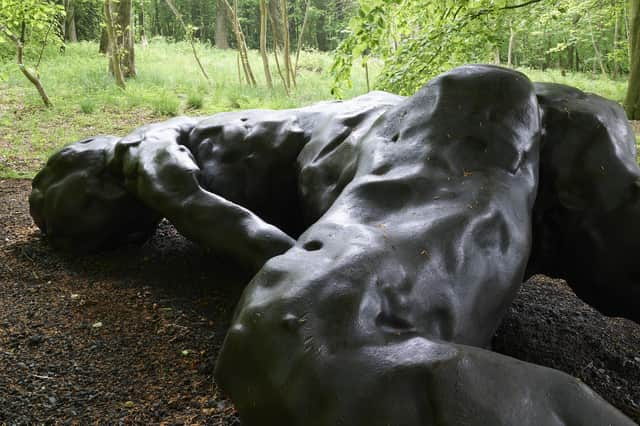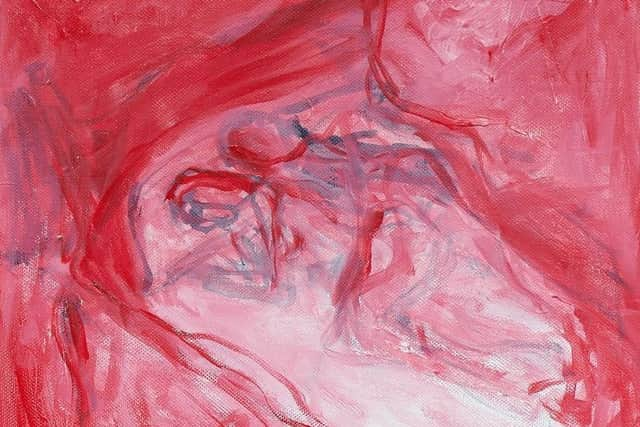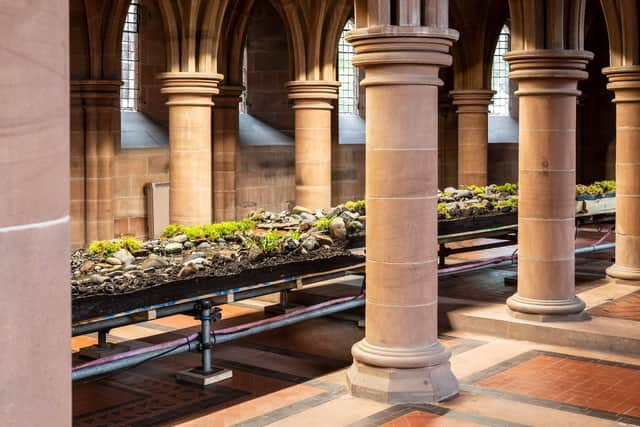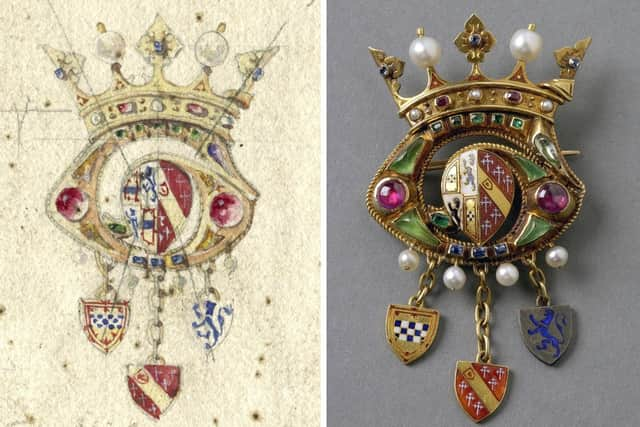Art reviews: Tracey Emin | Abbas Akhavan | Fantasy to Fabrication


Tracey Emin: I Lay Here For You, Jupiter Artland, Edinburgh ****
Abbas Akhavan: Study for a Garden, Mount Stuart, Isle of Bute ***
Fantasy to Fabrication, Mount Stuart, Isle of Bute ***
Advertisement
Hide Ad

What is it with Tracey Emin and beds? The artist’s name will be for ever linked to her 1998 installation My Bed, perhaps the most famous work not to win the Turner Prize (it was shortlisted, and enjoyed much more coverage than Steve McQueen, who actually won). The bed, she said, with its condoms and vodka bottles, was a portrait of a time in her life. Usually, one can’t assume an artist’s work is autobiographical. With Emin, we’ve learned, you can.
Now, the enfant terrible of BritArt is Dame Tracey, one of the country’s most celebrated artists. Her work, though, is still visceral, in your face, searingly honest, coming straight from the life, the heart, the gut, the bed. The exhibition, which accompanies the installation of a new permanent sculpture at Jupiter Artland, reflects her last two years, a battle with cancer, invasive surgery, and a vibrant return to the studio.
The sculpture, I lay here for you, is a monumental six-metre bronze nude, now lying on a bed of dead leaves in a grove of tall trees. The woman lies on her front, her left arm tucked under her body, her skin lumpy, her bum slightly lifted. She is the opposite of the demure, idealised nude usually made with and for the male gaze. She is a flesh and blood woman who doesn’t care a straw for the male gaze, or the male anything else. She could be dreamily post-coital, or (as Emin playfully suggested when the work was unveiled) simply pleasuring herself.
She was made in 2018, but the paintings and prints in the rest of the show are more recent. This is one of the first exhibitions made since Emin’s recovery and while A Journey to Death, earlier this year in Margate, was a no-holds-barred confrontation with mortality, this one is focused on life. If the two great subjects of art are sex and death, that show was death, this one is sex.


There are a lot of beds. She made a series of identical lithographs of beds on to which she drew with Indian ink, adding furniture, objects and figures. Often two bodies embrace, touch or lie side by side. Sometimes, a single figure curls up on the bed, between pain and sleep. They are tender and vulnerable and often defiant. One is called Because I am so f****** sexy. I was born sexy and I will die sexy.
There are more beds among her paintings. In I keep bleeding, two figures hold each other in a bed which is hollowed out of a blood red background, as if floating on a sea of pain. Two small paintings of (unoccupied) beds have a quiet restraint to them: has the occupant died or recovered, or just moved on? The larger paintings buzz with energy. Paint drips, runs, smears. They are expressive, instinctive, the image half-obscured in the movement, as if mark-making were at least as important as the subject. They are, perhaps, an artist painting her return to life.
Advertisement
Hide AdIf Emin’s early work seemed possessed of a tendency to overshare, we might reconsider it now in the light of this. These works are raw, intensely physical, ultimately life-affirming. They’re no less personal, but they are more nuanced. Her 1998 film Homage to Edward Munch and all my dead children is included here because it’s in Jupiter’s collection, but it shows how far her work has come. Twenty-four years ago, she captured Munch’s existential scream. Now she’s painting pain and love and comfort and compromise and defiance. She’s painting real life.
Emin’s obvious pleasure at seeing her work find a home outdoors is echoed at the other side of the country by Iranian artist Abbas Akhavan, this year’s incumbent at the contemporary art programme at Mount Stuart on the Isle of Bute. Akhavan, who is based in Canada, elegantly sidesteps Mount Stuart’s heavily decorated interior by focusing on the gardens.
Advertisement
Hide Ad

His largest work brings the outside in. In the crypt of the house he recreates a stream. With stones, mosses, plants and gurgling, tumbling water, Variations on a folly looks a lot like the real thing, were it not raised on a scaffold and hooked up to a recycled hosepipe. It’s rather beautiful, but feels labour-intensive for a conceit which seems chiefly to poke fun at the absurdity of landowners who commissioned man-made ruins and artificial waterfalls for their own delectation.
Walking from there to the other main works in the kitchen garden takes about 20 minutes, just enough time to listen to Akhavan’s sound work you used to call it blue sometimes (accessed by QR code, or on a borrowed MP3 player). In it, he roughly splices together found audio from colourblind people seeing colours for the first time with a narrative about bird taxonomy, in particular how western naturalists named new species after themselves as if no one else of consequence had seen the bird until then.
At the glass pavillion in the kitchen garden, he follows up the colour theme by covering sections of glass with transparent dichroic film, playing with what we see and perceive. Meanwhile, inside, in a film called Slug, a crude puppet face made from flower petals sounds off about nightmares, while edging towards the real-life nightmare of environmental catastrophe.
If there is an overarching theme to this body of work, perhaps it is the imperious attitude of human beings towards the natural world. But is this subject not highly ironic within an impeccably managed man-made landscape like Mount Stuart? Any art placed here needs to fend for itself in terms of its production values and the clarity of its ideas. For me, this odd assortment of works fell a little short on both counts.
Meanwhile, Fantasy to Fabrication, in Mount Stuart’s Armoury, aims to present some of the stories about the decorative objects in the house’s collection. Meticulously researched by curator Jessica Insley, it presents carefully chosen examples of stained glass, metalwork, furniture, blown glass, lighting and jewellery, tracing the stories of their commissioning, designing and making.
One highlight is the marriage brooch made for Gwendolen, wife of the 3rd Marquess, a gift to her from the architect and designer William Burges, a favourite of the Butes. It’s emblematic of the Arts and Crafts movement, when those who could afford it eschewed mass-produced design and embraced the hand-made and the inspiration of the past (the brooch was inspired by a Tudor one in a portrait of Katherine Parr).
Advertisement
Hide AdLooking at the objects, from silver plate to wooden furniture, one starts to discover personalities – the Marquesses who commissioned and collected, the craftsmen who made and the designers: Burges and Lonsdale and (the under-appreciated) Robert Weir Schultz. Objects take on character, like the spectacular Cat Cup which Burges made for his own collection (it came to the Butes after his death), and the Bute Cruet, design by Burges as a birthday gift from Gwendolen to her husband.
Though this is not a large exhibition, it requires time, due to the richness of information in it. While this is the tip of the iceberg in terms of the wealth of objects at Mount Stuart, it does help us to begin to see how precious things can be better understood, and be allowed to tell their own stories.
Advertisement
Hide AdTracey Emin: I Lay Here For You, until 2 October (sculpture is permanent), see www.jupiterartland.org; Abbas Akhavan: Study for a Garden, until 2 October; Fantasy to Fabrication, until 30 October, see www.mountstuart.com